The Search For The Crash Site of Major Thomas B. McGuire, Jr.
by David J. Mason
In memory: David Mason passed away July 13, 2024.
McGuire's Last Mission
On Sunday January 7, 1945 at approximately 0710 local time a flight of four U.S. Army Air Force (USAAF)
P-38 Lightnings were conducting a fighter sweep of the northern part of
Negros Island in the central Philippines. Leading "Daddy Flight" was Major Thomas B. McGuire, Jr. piloting P-38L Lightning 44-24845 with wingman Major Jack B. Rittmayer plus element leader Captain Edwin R. Weaver and wingman 2nd Lt. Douglas S. Thropp, Jr.
Their mission was to
search for and engage any airborne Japanese aircraft they might encounter. After
circling Fabrica Airfield they headed for Carolina AIrfield. Approximately three miles from the Carolina Airfield
they suddenly observed a lone Japanese single engine fighter aircraft
flying below them and heading directly towards them. As the Japanese
aircraft passed directly underneath the flight leader an intense aerial
engagement broke out. In less than two minutes two of the P-38
fighters lay burning on the ground, their pilots killed. The two
remaining P-38’s continued to fight the lone enemy fighter but
eventually sought the safety of the overcast clouds and headed back to
their base on Leyte. The lone Japanese fighter apparently got away
undamaged.
The news of this dogfight
devastated the morale of the American fighter pilots prosecuting the
war against the Japanese. The
top Army brass immediately slapped a “Top Secret” classification
on any talk of this incident. For two decades after the war any
details of this incident was kept from the public. Finally in the
late 1960’s the Freedom of Information Act finally opened up the
military’s records on this incident and allowed military historians
to finally learn the truth about what happened that day over Negros Island.
Why
was this incident so sensitive to the U.S. military? Because on that day America lost one of the greatest
fighter pilots in its history. Major Thomas B. McGuire, Jr. aged
24 from Ridgewood, New Jersey. Major McGuire was the top ace of
the 475th Fighter Group of the Fifth Fighter Command with 38 confirmed
aerial victories. He ranked second only to Major Richard I. Bong who had been credited with 40 victories. At the time of his death
Major McGuire was the highest scoring American ace still involved in
air combat against the enemy. At war’s end Major McGuire’s
total of 38 victories would place him as the second leading American
ace of World War II. Major McGuire was also one of the highest
decorated pilots during WW II and was posthumously awarded the nation’s
highest award, the Congressional Medal of Honor. Today McGuire
Air Force Base located near his home town in New Jersey stands as a daily
reminder of his sacrifice.
What sparked my interest in this incident
was just how could such a superb fighter pilot as Major McGuire meet
such an unlikely fate during a seemingly routine combat patrol? And
just who was that Japanese fighter pilot that took on four P-38’s,
caused two of them to crash, chased the other two away, and apparently
got away without a scratch? I also wondered exactly where Major
McGuire went down and if there were any parts of his aircraft left at
the crash site. I really wanted some answers to these questions. Unfortunately
there were no easy answers to be found in the history books. In
fact searching the internet and the history books I found about five
different versions of what happened to Major McGuire that day. I
couldn't help but wonder which version was really the truth. So
in 2000 I decided to undertake my own investigation into this tragic
incident.
As a former USAF fighter pilot and
mishap investigator I felt my military training and experiences might
come in very handy in this investigation. It was also very helpful
that I live in the Philippines, speak a little Filipino, am familiar
with Negros Occidental, and that I'm an airline pilot with
the ability to travel for free anywhere in the world that this investigation
might presumably take me.
|

Major McGuire with
P-38L“Pudgy (V)” 44-24155
January 5, 1945

P-38s over Leyte Gulf

P-38L Lightning
44-248445
|
Background Research
My first step was to gather as much information about this incident
as possible. I first contacted Mr. Charles Martin who authored the
book The Last Great
Ace which is a biography on the life of Major McGuire. I
traveled to his home in Jacksonville, Florida to meet with him. He
very graciously opened up some of his files to me and referred me to some
other key people that had helped him in writing his book. Most notably
he introduced me to Mr. Doug Thropp. On January 7, 1945 2nd Lieutenant
Doug Thropp was flying as Major McGuire’s number four wingman on
that fateful day and witnessed his fatal crash. I traveled to Mr.
Thropp’s home in Richmond, Virginia and interviewed him extensively. We
went over every detail of the mission and for the first time drew out detailed
diagrams of the engagement that took place. The information that
Mr. Thropp provided to me was invaluable in this investigation.
Mr. Thropp in turn referred me to Master Sergeant Gary Boyd of McGuire
AFB and to Lee Northrop the Director of the 475th Fighter Group Museum
located at March AFB, California. I traveled to McGuire AFB to
meet with Sergeant Boyd and received from him some extremely relevant
documents pertaining to this incident that had been released under the
Freedom of Information Act. He also referred me to Mr. Michael
Terry, an aviation historian, who also provided me with some important
documents along with a recording of Major McGuire’s CBS radio interview
conducted shortly before his death. For the first time I was able
to put a voice to the many pictures I had collected of Major McGuire.
I then traveled to March
AFB, California to meet with Mr. Lee Northrop. Lee very graciously
opened up the 475th Fighter Group Museum’s archives to me and
allowed me to search through their unit history logbooks, maintenance
records, and aircraft logbooks as well as viewing never before published
photographs and documents that detailed the day to day operations of
the 431st Fighter Squadron and the 475th Fighter Group. What
I was able to learn in doing so helped me determine the history and
the condition of Major McGuire’s mishap aircraft and understand
why Major McGuire was not flying his personal “PUDGY V” aircraft
that day. This information would later prove invaluable. Lee
also referred me to Mr. Craig Anderson who is the son of Carroll Anderson.
Carroll Anderson was a fellow pilot in the 475th Fighter Group and frequently
flew with Major McGuire on combat missions over New Guinea. In the
early 1970’s, on his own imitative, Carroll Anderson launched the
first and only investigation into Major McGuire’s fatal mission. At
the end of his investigation he wrote a superb article describing what
happened and titled it “McGuire’s Last Mission”. This
article was eventually published in the January 1975 issue of Air Force
Magazine.
I then traveled to Craig Anderson’s home in Linden, California where
he allowed me to view all of his dad’s old files. While casually
reviewing these old files dating back to the 1970’s I came across
a hand drawn map written in Japanese. Looking a little deeper I discovered
that this map had apparently been drawn by the Japanese fighter pilot that
had engaged Major McGuire’s flight that day.
|

Martin's excellent book
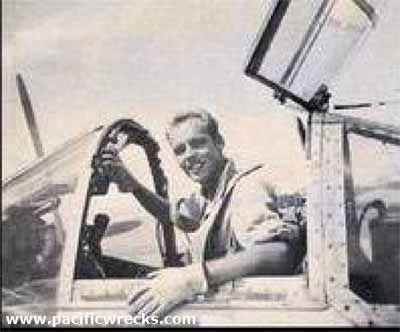
Lt. Carroll Anderson in 1943
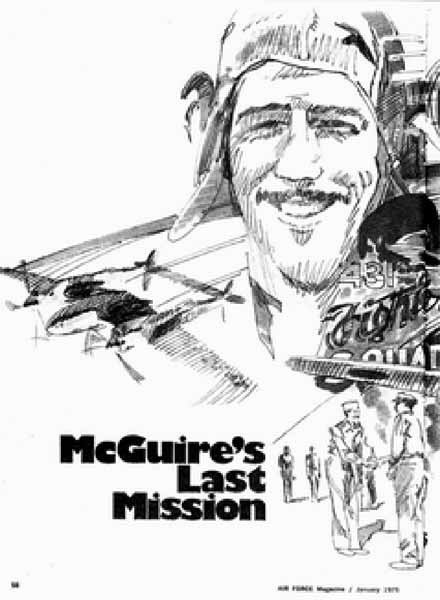
McGuire's Last Mission

Son Craig Anderson
with David Mason
|
Japanese Side of the Story
In his investigation in the 1970’s, Carroll Anderson had
discovered that there was not just one Japanese plane involved in the dogfight
but two planes. He was also able to learn the identity of the two
Japanese pilots and had contacted one of them to get their side
of the story.
The surviving Japanese pilot eventually provided Mr.
Anderson with a description of what had happened along with a hand drawn
map of northern Negros where the dogfight had occurred. After the mission, the Japanese pilot drew a map and clearly identified where Major McGuire had crashed. This
map, hidden away for 25 years, became the lynch pin that led me to successfully
locate Major McGuire’s crash site and eventually recover artifacts
from his aircraft.
Even more remarkably I discovered that the Japanese pilot was still
alive and residing in Kagoshima, Japan. His name is Mr. Mizunori
Fukuda and I was able to contact him and receive permission to interview
him. The information provided by Mr. Fukuda proved to be invaluable
in this investigation. Not only about the location of Major McGuire’s
crash site but also about his and the other Japanese pilot, Warrant Officer
Akira Sugimoto’s, background and detailed information about what
happened during the dogfight and how Major McGuire may have been killed.
As it turns out both Warrant Officer Sugimoto and Sergeant Fukuda were
highly experienced air combat instructor pilots with many thousands of
hours in single engine fighters. They also had extensive combat
experience dating back to 1941 and recent combat experience against P-38’s
and P-51’s over Leyte. They were also flying two of the highest
performance aircraft in JAAF service, the Ki-43-III Oscar and the Ki-84A Frank. It
was no surprise that they handled themselves so competently against the
four P-38’s in Major McGuire’s flight that day.
|

Fukuda's hand drawn map

Sergeant Fukuda
with students in 1942 |
Visit to Negros Island
After almost a year of research I finally decided I had enough
information to warrant a field trip to Negros, Occidental. On January
5th, 2001 I traveled to Bocolod City the capitol of Negros Occidental and
assembled my search team. Assisting me would be Edwin Kho, an archeology
student from Bocolod City University, along with his driver and an armed
university security guard. The area that we would be working in was
not totally secured from MLF and NPA terrorist activity so we wisely took
these precautions. Edwin was also familiar with the area we would
be searching in and had already recovered numerous WW II artifacts. Equipped
with detailed maps, metal detectors, cameras, GPS receivers, digging tools,
communication equipment, and plenty of funding we proceeded north to the
area where the dogfight had occurred.
We immediately located the abandoned at Carolina Airfield where Mr.
Fukuda had been based. There we observed the concrete remains of
the command post bunker that Mr. Fukuda had told us formed the center
reference point of his hand drawn map. We then proceeded to locate
and interview elderly local Filipinos that had been living in this area
during the occupation. We located one individual, Mr. Orinco Remagio,
who had been conscripted by the Japanese in 1942 and who was forced to
work as a laborer at the Carolina Airfield until February 1945. He
was very helpful in providing us with detailed information regarding
runway orientation, aircraft parking areas, and day-to-day operations
at this airfield. He also directed us to an area where he said
numerous Japanese aircraft were junked after the war. Using a metal
detector we were able to recover numerous Japanese 20mm shell casings
and an HO-5 20mm cannon. The Ho-5 is the same type of weapon used
by Mr. Fukuda’s Ki-84A Hayate fighter aircraft. Unfortunately
we did not locate any significant aircraft parts.
The following day Mr. Remagio led us to a field south and west of the Carolina Airfield where an American aircraft had crashed during the war. He
and some other workers were led there on a work detail in early 1945
to load parts from that aircraft and bring them to the Carolina Airfield. He
advised us that the Japanese officers showed a lot of interest in examining
the wreckage. Unfortunately he could not offer any description
of that aircraft or what may have happened to the pilot. We searched
the area with metal detectors but did not locate anything significant. In
a follow up interview with Mr. Fukuda he advised me that this was the
P-38 aircraft that he had shot down and that his fellow officers were
trying to confirm the aerial victory for him. Although I have not
yet been able to positively confirm this fact it is probable that this
was the P-38 aircraft of Major Jack Rittmayer, who was flying as Major
McGuire’s number three wingman.
|
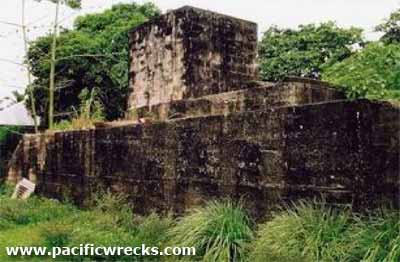
Remains of the command bunker
at Carolina Airfield
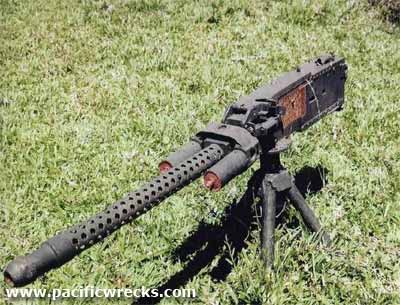
Japanese HO-5 20mm cannon recovered
at the Carolina Airfield |
After completing our inspection of
the Carolina Airfield complex we followed Mr.
Fukuda’s map and proceeded to an area approximately three miles
to the east. In this area we proceeded to a plantation identified
as Hacienda Progresso. This plantation was identified in a U.S.
Army Search and Recovery report as the location where Major McGuire’s
remains were recovered in 1947.
While at this location we made contact with the current owner of the
land, Mr. Bert Capay, but he could not offer any information to us regarding
this incident. He did however identify an elderly woman by the
name of Lourdes Cosa who had worked as a maid for the plantation owner,
Mr. Vladimir Terrogoff, during WW II and that she might provide us with
some information on this incident. Eventually we located her in
the nearby city of Cadiz and interviewed her. Although she did
remember the plane crashing near the owner’s house she could not
pin point the exact location of the crash site. She did however
refer us to the plantation foreman Mr. Vincente Bedoria whom she said
lived in the nearby city of Conception.
The following day January 7th, 2001 we located the residence of Mr.
Bedoria and sat down to interview him. We told him that we were
investigating the crash of a plane in this area towards the end of WW
II and if he knew anything about it? He replied: “Oh yes,
I certainly do!” To my surprise he accurately described the
type of aircraft involved, the markings on that aircraft, the time of
day, the presence of three other “double body” aircraft,
the presence of a Japanese single engine aircraft, and provided us with
a description of the personal equipment that the pilot had been wearing.
Of
particular interest was his statement that the pilot was wearing an
unusual gold ring with a black stone. He also described the condition
of the pilot’s remains and how he and some other workers had
placed the pilot’s remains in a wooden box and carried it to
the owner’s house. There they buried it under a large tree
and replaced the grass so it would not look like a freshly dug grave. He
then described how he had made contact with U.S. Army troops in 1947
and led them to the grave site where they took custody of the body.
The
information that Mr. Bedoria provided us with was cross referenced
with the U.S. Army’s 1947 Search
and Recovery Report, Major McGuire’s autopsy report, Major McGuire’s
Missing Aircrew Report, and most vividly a photograph taken on January
5th, 1945. In this photo. taken two days before his death, Major
McGuire is clearly seen wearing a black and gold ring on his left ring
finger. Without reservation I determined that Mr. Bedoria had
indeed witnessed Major McGuire’s crash and had assisted in recovering
and securing his remains so they would not fall into the hands of the
Japanese.
I then asked him to lead us to the crash
site. After a 15-minute walk he led us to the western slope of
a shallow ravine and standing midway up the slope stated that this
is where the plane came to rest.
At the location that he directed us to look we began excavating the soil
and over the next three days recovered more than 200 pieces of metal parts. One
part we recovered was a 5-inch round geared pulley. This geared pulley
was a precisely manufactured part recovered approximately 10 inches under
ground in the middle of the crash site and showing extensive corrosion. Eventually
this part was taken back to the U.S. and positively identified as a part
of the window cranking assembly of the P-38 aircraft. This part is
unique to the P-38 aircraft. We also recovered two
.50 caliber brass shell casings with unfired primers, heavily corroded and showing extensive
evidence of heat stress, and stamped with the number “4” on
the casing base. We also recovered a single
20 mm HEI bullet fragment that was also extensively corroded.
Based on the testimony of Mr. Bedoria,
the recovery of unmistakable P-38 aircraft parts at the location, the
U.S. military documentary evidence, and the direct testimony from Mr.
Fukuda and Mr. Doug Thropp I determined that this was in fact the
crash site of Major McGuire’s aircraft.
The artifacts
recovered at the crash site have been donated to the Clark Air Base Museum
as part of a display honoring Major McGuire. It was in the sky
over Clark Airfield on December 25th and 26th that Major McGuire distinguished
himself and was subsequently awarded the coveted Medal of Honor. Today, a memorial marker with the following inscription has been placed at the
crash site identifying the location of Major McGuire’s death.
During my investigation into Major
McGuire’s unfortunate mishap I tried to rely on direct eyewitness
testimony from individuals directly involved in the dogfight and on
the evidence collected at the crash site. I also conferred with
many P-38 pilots from the 475th Fighter Group who flew with Major McGuire
and knew him personally. I feel the conclusions that I have drawn
concerning the dogfight over Negros on January 7th, 1945 are the best
idea we may ever have as to what really happened that day. I
am currently writing a final report describing the details of the dogfight
and analyzing exactly what happened. I hope to eventually establish
a website on this incident and make my final report available on
the internet.
I would like to thank the following individuals
for their extremely valuable assistance in conducting this investigation:
Mr. Charles Martin
Mr. Doug Thropp
Mr. Mizunori Fukuda |
Mr. Craig Anderson
Mr. Lee Northrop
MSgt Gary Boyd |
Mr. Michael Terry
Mr. Vincente Bedoria |
Without their help this investigation would not have been possible.
David J. Mason |
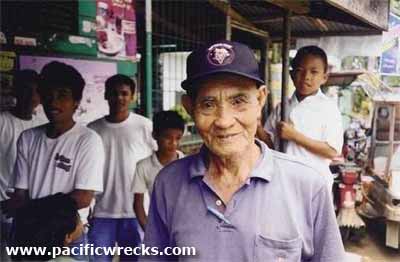
Mr. Bedoria who witnessed Major McGuire’s
crash and recovered his body

Major McGuire posing with P-38L-1 “PUDGY
V” on January 5th, 1945
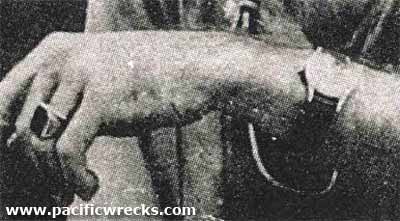
Close up view of the black onyx and gold ring
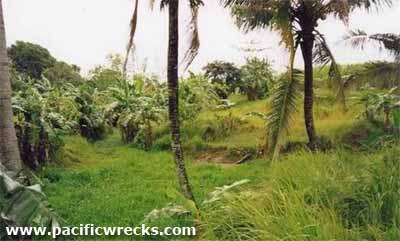
View of Major McGuire’s crash site looking west across the ravine
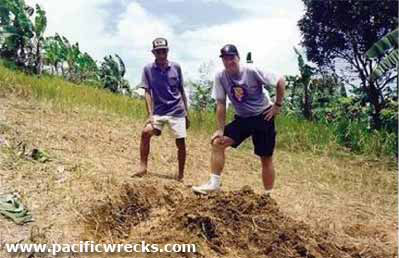
Bedoria and Mason
at the crash site
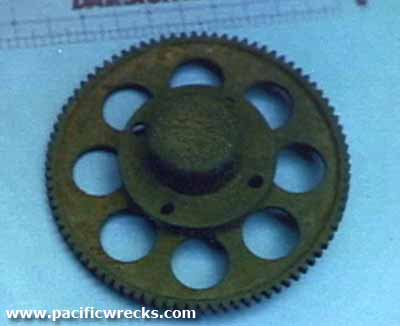
5" geared pulley
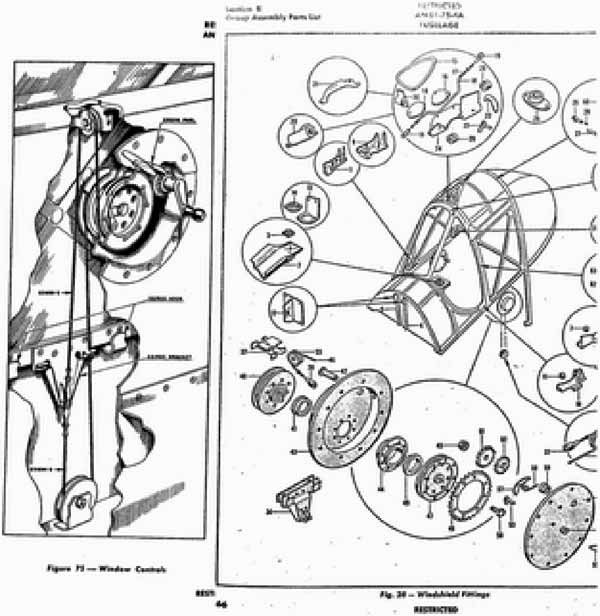
Lockheed P-38 parts manual showing location of
pulley
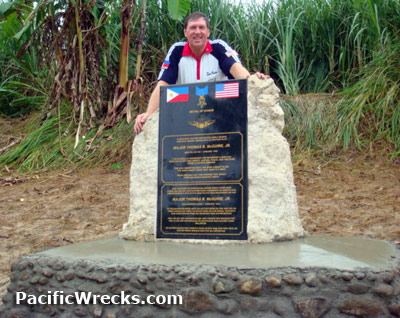
David Mason with memorial at McGuire crash site 2008

David Mason with memorial at McGuire crash site 2024 |
Contribute Information
Do you have photos or additional information to add?
|


















